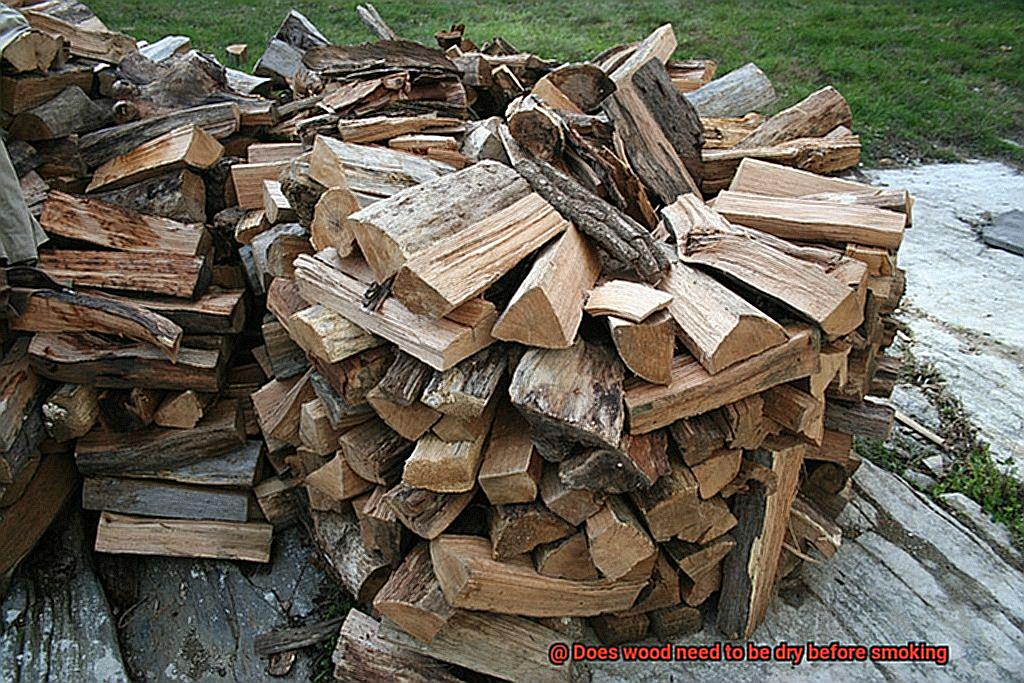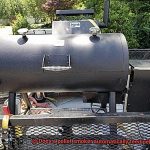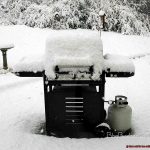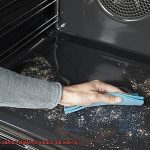If you’re a fan of smoked meat, then you know that the flavor is like no other. The tantalizing aroma wafting from the smoker can make your mouth water in anticipation. But to achieve that perfect smoky flavor, it’s essential to choose the right type and quality of wood for smoking. And one question that often comes up is, ‘Does wood need to be dry before smoking?’ It might seem like a small detail, but using damp wood could ruin your dish and even pose health risks.
The answer is straightforward: yes, wood needs to be dry before smoking. There are several reasons for this. For starters, wet wood produces too much smoke, which can result in a bitter taste and an unpleasant smell. Secondly, wet wood releases creosote – a harmful chemical that can damage your smoker and harm your health. Lastly, dry wood burns more efficiently, creating consistent temperature and smoke throughout the cooking process.
So how do you ensure that your wood is dry? Well, there are several steps you can take to prepare your wood for smoking – from seasoning to storing. Whether you’re a seasoned pro or just starting out on your smoky journey, it’s crucial to pay attention and take notes. This knowledge will make all the difference in achieving that perfect smoky flavor every time.
In conclusion, if you want to elevate your smoked meats’ flavor profile, it’s essential to use dry wood when smoking. By following the proper preparation methods for drying out your chosen type of wood thoroughly, you’ll be sure to impress everyone at your next barbecue gathering.
Contents
The Benefits of Dry Wood for Smoking
Then, it’s time to consider the benefits of using dry wood for smoking. The moisture content in wood can significantly affect the flavor and quality of the smoke produced. Let’s explore the advantages of using dry wood and why it’s essential for the perfect smoky taste.
First and foremost, dry wood burns hotter and more evenly than wet wood. This is crucial for maintaining a consistent temperature inside the smoker, which is necessary for cooking meats to perfection. Not only that, but it also produces less creosote buildup inside the smoker, reducing the risk of fires and making cleaning up a breeze.
But that’s not all – dry wood also produces a cleaner, pure smoke that enhances the natural flavors of the meat. Wet wood tends to release a lot of steam, diluting the smoke and potentially causing an unpleasant, bitter taste. With dry wood, you have complete control over the intensity of the smoke, allowing you to adjust it according to your preferences.
Now, knowing when your wood is dry enough for smoking is just as important as using dry wood itself. One way to check is by using a moisture meter to determine if the moisture content is below 20%. Alternatively, look for visible signs of dryness such as cracks or splits in the wood.
How to Tell if Wood is Dry Enough for Smoking
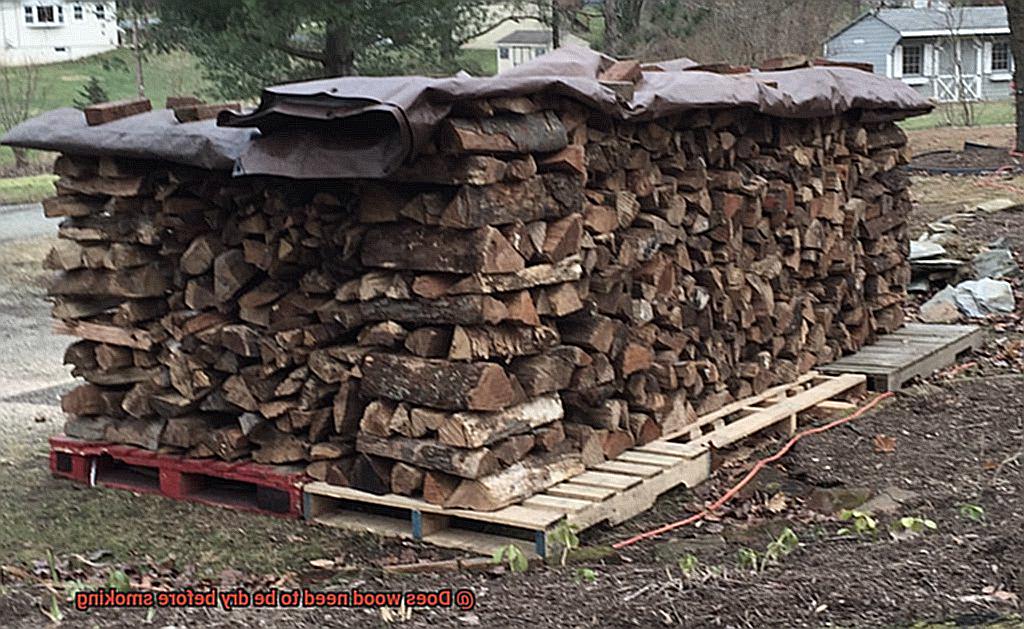
Smoking meat is an art that requires precision and patience. One of the most important aspects of smoking meat is using dry wood. The moisture content of the wood can significantly affect the flavor of the meat. Wet or green wood can lead to excess smoke and create a bitter taste in the meat. Here are some methods to determine if your wood is dry enough for smoking.
Check the Moisture Content
A moisture meter is a handy tool that you can use to measure the moisture content of your wood accurately. Ideally, the moisture content of smoking wood should be between 10% and 20%. Anything above 20% means that the wood is too wet and could cause issues when smoking.
Test the Weight
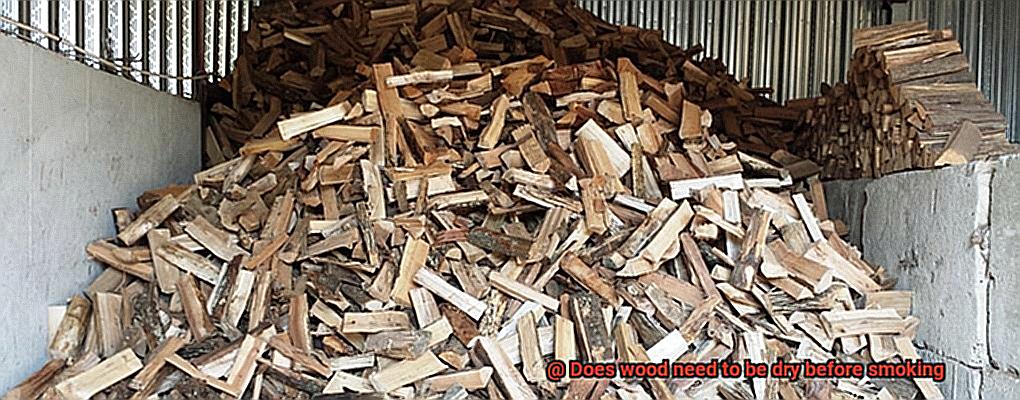
Another way to tell if your wood is dry enough for smoking is to test its weight. Dry wood will weigh less than wet wood. You can compare the weight of your wood with another piece of the same type that has been sitting out in the sun for a few days. The drier piece will be lighter in weight.
Give it a Knock
Dry wood will make a sharp, high-pitched sound when tapped, while wet wood will produce a dull thud. So, give your wood a knock to see if it’s dry enough for smoking.
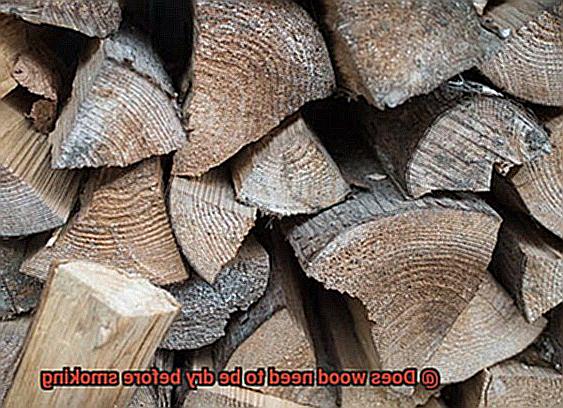
Look for Visible Signs of Dryness
Visible signs of dryness such as cracks or splits in the wood indicate that it’s dry enough for smoking. If you see cracks or splits, it’s a good indication that you can use it for smoking.
Split Open the Logs
If you’re using logs for smoking, split them open and check the color of the inside. If it’s light-colored and dry, then it’s ready for smoking. If it’s dark or damp, then it needs more time to dry.
Smell the Wood
Lastly, you can also smell the wood to determine if it’s dry enough for smoking. Wet wood will have a musty or moldy smell, while dry wood will have a pleasant, woody aroma.
Why Does Wet Wood Produce Bitter Flavor?
For those of us who love to barbecue and smoke meat, the flavor of our dishes is everything. But did you know that the moisture content of the wood you use can make a huge difference in the final taste? If you’re using wet wood for smoking, then it’s time to pay attention to this expert advice.
Firstly, let’s dive into why wet wood produces a bitter flavor. When you use wet wood for smoking meat, it produces more smoke than dry wood. This excess smoke can lead to over-smoking, which can result in an unpleasantly bitter taste. Additionally, the excess moisture in wet wood causes it to burn at a lower temperature, leading to a prolonged burning time. This extended burning time can cause the wood to release more tar and creosote, which can create a bitter taste when mixed with the meat’s juices.
But that’s not all – there’s another factor at play here. Wet wood is a perfect breeding ground for mold and bacteria, which produce toxins and off-flavors when exposed to heat and smoke. Yuck. So not only can your dish taste bitter, but it can also be unsafe to consume.
So, what’s the solution? The best option is to use dry wood for smoking meat. This way, you’ll avoid any unwanted bitterness or potential health hazards. But if you find yourself in a pinch with only wet wood available, don’t worry. You can still salvage your dish by drying out the wood as much as possible before use. You can store it in a dry place for several days or use a dehumidifier to remove excess moisture.
How Can Moisture Content Be Checked?
Well, here’s a hint: it all starts with the moisture content of your wood. Yes, that’s right. The moisture level in your wood can make or break your dish. So, let’s explore the different ways you can check the moisture content of your wood before smoking.
First on the list is the handy moisture meter. This nifty device measures the amount of moisture in your wood by using two metal pins that penetrate deep into the wood. The device then displays an accurate reading of the moisture content on a digital screen. It’s quick, easy, and ensures that you get an accurate reading of your wood’s moisture level.
But what if you don’t have access to a moisture meter? No problem. The squeeze test is another simple way to check the moisture content of your wood. It involves squeezing a piece of wood tightly in your hand and then releasing it. If it springs back quickly, it’s dry enough for smoking. If it takes some time to spring back, it has some moisture content. And if it doesn’t spring back at all, it’s too wet and should not be used for smoking.
Lastly, you can also check the weight of the wood before and after drying. This method involves weighing a sample of the wood before drying it and then weighing it again after it has been dried in an oven or dehydrator. The difference in weight indicates the amount of moisture in the wood.
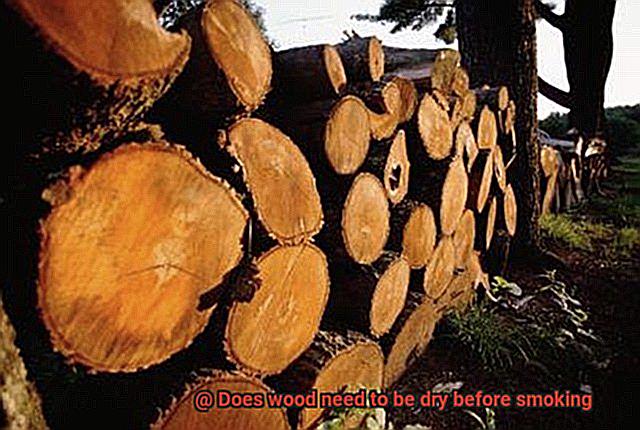
It’s crucial to note that different types of wood have different ideal moisture contents for smoking. Generally, hardwoods should have a moisture content between 10-20%, while softwoods should have a moisture content below 15%. It’s always best to research the specific type of wood you plan on using before smoking to ensure optimal results.
Tips for Drying Wood Before Smoking
When it comes to smoking meat, the type of wood you use can make all the difference in flavor and texture. But even the best wood can produce subpar results if it’s not dried properly beforehand. Here are some tips for drying your wood before smoking:
Start with properly seasoned wood
Before you begin any drying process, ensure that your wood has been properly seasoned. This means allowing it to dry for several months after cutting, ideally in a well-ventilated area. The length of time needed for seasoning will vary depending on the type of wood and your climate. Hardwoods like oak or hickory may need up to six months, while softer woods like pine may only require a few weeks.
Air-dry your wood
Air-drying is a popular method for drying wood and involves leaving it outside to dry naturally. However, it’s essential to keep your wood off the ground and out of direct sunlight to prevent warping or cracking. Covering the wood with a tarp or other protective covering will also help keep it dry during inclement weather.
Use a fan or dehumidifier
If you want to speed up the drying process, consider using a fan or dehumidifier to circulate air and remove moisture from the wood. However, be sure to monitor the moisture content regularly to avoid over-drying.
Consider using a kiln
Using a kiln is another option for drying your wood before smoking. A kiln is specifically designed for drying wood and allows you to control the temperature and humidity levels for even drying. However, this option requires specialized equipment and may not be feasible for everyone.
Monitor moisture content
Regardless of which method you choose, it’s crucial to monitor your wood’s moisture content throughout the drying process. You can use a moisture meter (available at most hardware stores) to check that your wood’s moisture content is between 10% and 20%. If the moisture content is too high, you’ll need to continue drying your wood for longer.
Be patient
Drying your wood properly can take anywhere from several days to several weeks, depending on the size and type of wood. Resist the temptation to rush the process; it’s essential to ensure that your wood is completely dry before smoking.
Different Types of Woods and Their Flavors
Smoking meat is a time-honored way to add depth and complexity to your dishes. But did you know that choosing the right type of wood can make all the difference? Each type of wood has its own unique flavor profile that can greatly impact the taste of your smoked meats. Let’s dive into the different flavors that various types of woods impart to food when used for smoking.
Hickory wood is a popular choice for smoking meats such as pork and beef. It has a strong, smoky flavor that can be overpowering if too much is used. The bold flavor of hickory pairs well with rich, fatty meats like bacon or pork shoulder. Mesquite, on the other hand, has a more intense, earthy flavor and is commonly used for grilling and smoking beef. The strong, robust flavor of mesquite is a great match for hearty cuts of meat like brisket or tri-tip.
If you prefer a sweeter, milder flavor, apple and cherry wood are great options. These fruitwoods offer a delicate sweetness that pairs well with poultry or fish. Apple wood has a subtle fruity aroma that works well with chicken or pork, while cherry wood offers a slightly tart flavor that complements salmon or trout. Oak is another versatile wood that can be used for smoking nearly any type of meat. It has a mild flavor that is not too overpowering and works well with just about anything.
Maple wood is another popular choice for smoking meats. It has a sweet, subtle flavor that pairs well with chicken or pork. The light, delicate flavor of maple wood works particularly well with ham or bacon. Other types of wood that can be used for smoking include pecan, alder, and peach. Pecan wood has a slightly sweet and nutty flavor that works well with chicken or turkey. Alder wood has a mild, slightly sweet flavor that pairs well with fish or seafood. Peach wood offers a subtle, fruity flavor that works well with pork or chicken.
Regardless of the type of wood used, it is important to ensure that it is dry before using it for smoking. Wet wood can produce too much smoke and cause the food to taste bitter or acrid. It can also make it difficult to maintain a consistent temperature in the smoker. Dry wood will burn cleaner and produce a more even smoke that will result in better-tasting food.
To ensure that your wood is dry enough for smoking, it should be seasoned or dried out for at least six months before use. This allows the moisture content to decrease to an appropriate level. If you are using store-bought wood chips or chunks, make sure they are labeled as dry or seasoned.
Pros and Cons of Wet vs Dry Wood for Smoking
Well, the answer is not as simple as you may think. There are pros and cons to both options, and as an expert in this field, let me enlighten you.
Using wet wood for smoking has its advantages. Firstly, it can create more smoke that enhances the flavor of the food being smoked. Secondly, it burns more slowly, which helps maintain a consistent temperature inside the smoker while preventing the food from drying out. However, too much smoke and creosote buildup are some of the drawbacks of using wet wood. These can result in an overpowering smoky flavor that may not be desirable and may affect future dishes.
Dry wood, on the other hand, can make it easier to control the temperature inside the smoker as it burns more quickly and cleanly. It produces less smoke, which may be preferable for those who want a milder smoky flavor in their food. However, food can dry out more quickly during the smoking process when using dry wood.
It is important to note that the type of wood used and moisture level ultimately depend on personal preference. Experimenting with different types of wood and moisture levels is crucial to finding what works best for you. Here are some additional factors to consider when making your decision:
Pros of Wet Wood
- Creates more smoke for enhanced flavor
- Burns slowly for consistent temperature
- Prevents food from drying out
Cons of Wet Wood
- Can produce too much smoke and creosote buildup
- May result in an overpowering smoky flavor
Pros of Dry Wood
- Burns quickly and cleanly for better temperature control
- Produces less smoke for a milder smoky flavor
Cons of Dry Wood
- May cause food to dry out more quickly
- Completely dry wood can be difficult to find or create
Common Mistakes with Wet Wood For Smoking
Let’s delve into one of the most common mistakes that can ruin your smoked meat: using wet wood. As an expert in smoking, allow me to share some essential tips with you on why it is crucial to use dry, seasoned hardwoods and avoid soaking them in water before smoking.
Firstly, using wet wood produces excess steam, which can negatively impact the taste and texture of your meat. The steam also causes the temperature to fluctuate, making it challenging to maintain a constant temperature. There is nothing worse than trying to smoke meat with unpredictable temperature fluctuations, turning your BBQ into a nightmare.
Secondly, using green wood is another mistake that many people make. Green wood is freshly cut and has not been seasoned or dried out properly. It contains sap and other impurities that can produce an unpleasant taste and aroma when burned. Additionally, green wood produces more smoke than dry wood, which can cause the meat to become bitter and overpowering.
Now, let’s debunk the myth that soaking wood in water before smoking will help keep it from burning too quickly. This is not true. Soaking wood in water does not prevent it from burning; instead, it produces more steam and reduces the amount of heat produced during combustion. This makes it challenging to maintain a consistent temperature and can ruin the flavor of your meat.
Lastly, not all types of wood are suitable for smoking. Some woods contain toxins or produce an unpleasant taste when burned, such as pine or cedar. It is best to stick to hardwoods such as apple, cherry, hickory or oak for smoking.
xEnwSWJwCpY” >
Conclusion
In conclusion, the answer to whether wood needs to be dry before smoking is a resounding yes.
Wet or green wood can result in unpleasant flavors and uneven burning. It’s important to properly season your wood by allowing it to dry for several months before using it for smoking.
So, take the time to properly prepare your wood and enjoy the delicious results of a perfectly smoked meal.

